#every time I see some pop culture depiction of a psycho
Note
It's weird that antipsychotics have a better reputation in pop culture than electroconvulsive therapy does, since while I've def heard of ECT fucking people up pretty bad even today, I've actually heard more people describe positive experiences from it than from antipsychotics. Not wading into whether or not shock treatment is good on the whole; I don't think I'd ever get it myself. Just noting the irony that antipsychotics don't have a reputation at least as bad, when besides Freddie de Boer I don't think I've ever heard anyone who took antipsychotics come out swinging for them like I have with ECT.
Strong suspicion i should some day sit down to research more rigorously is that there has been a massive pharma propaganda campaign to get the public on board with antipsychotics. The amount of positive presentation it gets in the wider culture otherwise just sort of boggles the mind
#ask#who canceled roger rabbit#every time I see some pop culture depiction of a psycho#saying they are soooo relieved to be off their pills! everything is so much clearer now!#and then they go craaaaazy#my third eye gets tingly
144 notes
·
View notes
Text
Psycho Analysis: Lucifer/Satan
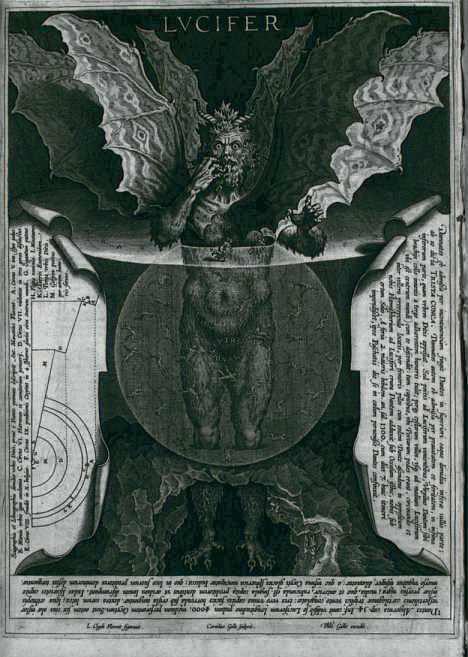
(WARNING! This analysis contains SPOILERS!)
Please allow me to introduce this villain. He’s a man of wealth and taste...
Satan, or Lucifer, or whatever of the hundreds of names across multiple religions, folk tales, urban legends, movies, books, songs, video games, and more that you choose to call him, is without a doubt the biggest bad of them all. He is not just a villain; he is the villain, the bad guy your other bad guys answer to, the lord of Hell. If there’s a bad deed, he’s done it, if there’s a problem, he’s behind it. There’s nothing beneath him, and that’s not just because he’s at the very bottom of Hell. He is the root cause of all the misery in the entire world.
And if we’re talking about Satan, we gotta talk about Lucifer too. They weren’t always supposed to be one and the same, but over centuries of artistic depictions and reimaginings they’ve been conflated into one being, a being that is a lot more layered and interesting than just a simple adversary for the good to overcome when handled properly.
Motivation/Goals: Look, it’s Satan. His main goal is to be as evil as possible, do bad things, cause mischief and mayhem. Rarely does anything good come from Satan being around. If he is one and the same as Lucifer, expect there to be some sort of plot about him rebelling against God, as according to modern interpretations Lucifer fought against God in battle and was then cast out, falling from grace like lightning. When the Lucifer persona is front and center, raging against the heavens tends to be a big part of his schemes, but when the big red devil persona is out and about, expect temptations to sin, birthing the Antichrist, or tempting people to sell their souls.
Performance: Satan has been portrayed by far too many people over the years to even consider keeping count of, though some notable performances of the character or at least characters who are clearly meant to be Satan include the nuanced anti-villain take of the character Viggo Mortensen portrayed in The Prophecy; the sympathetic homosexual man portrayed by Trey Parker in South Park and its film; the hard-rocking badass Dave Grohl portrayed in Tencaious D’s movie; Robin Hughes as a sneaky, double-crossing bastard in “The Howling Man” episode of The Twilight Zone; the big red devil from Legend known as Darkness, played by Tim Curry; the shapeshifting angel named Satan from The Adventures of Mark Train who will make you crap your pants; and while not portrayed by anyone due to being entirely voiceless, Chernabog from Disney’s Fantasia is definitely noteworthy in regards to cinematic depictions of the devil.
Final Thoughts & Score: Satan is a villain whose sheer scope dwarfs almost every other villain in history. It’s not even remotely close, either; Satan pops up in stories all around the world, is the greater-scope villain of most varieties of three major religions, and his very name is shorthand for “really, really evil.” Every other villain I have ever discussed and reviewed wishes they could be a byword for being bad to the bone. Even Dracula, one of the single most important villains in fiction, looks puny in comparison to Satans villainous accomplishments.
Satan in old religious texts tended to be an utterly horrifying force of nature, until Medieval times began portray him as a dopey demon trying to tempt the faithful (and failing). Folklore and media have gone back and forth, portraying both in equal measure – you have the desperate, fiddle-playing devil from “The Devil Went Down to Georgia” and the unseen, unfathomable Satan who may or may not exist in the Marvel comics universe who other demons live in fear of the return of. Satan is just a very interesting and malleable antagonist, one who is defined just enough that he can make a massive, formidable force while still being enough of a blank slate that you can project any sort of personality traits onto him to build an intriguing foe.
One of the most famous examples of this in action is the common depiction of Satan as the king of hell. This doesn’t really have much basis in religion; he’s as much a prisoner as anyone else, though considering how impressive a prisoner he is, he’d be like the big guy at the top of the pecking order in any jail for sure. But still, the idea of Satan as the ruler of hell was clearly conceived by someone and proved such an intriguing concept that so many decided to run with it.
I think that’s what truly makes Satan such an interesting villain, in that he’s almost a community-built antagonist. People over the ages have added so much lore, personality, and power to him that is only vaguely alluded to in old religions to the point where they have all become commonplace in depictions of the big guy, and there really isn’t any other villain to have quite this magnitude on culture as a whole. It shouldn’t be any shock that Satan is an 11/10; rating him any lower would be a heinous crime only he is capable of.
But see, the true sign of how amazing he is is the sheer number of ways one can interpret him. You have versions that are just vague embodiments of all that is bad and unholy, such as Chernabog from Fantasia, you have more nuanced portrayals like the one Viggo Mortensen played in The Prophecy, you have outright sympathetic ones like the one from South Park… Satan is just a villain who can be reshaped and reworked as a creator sees fit and molded into something that fits the narrative they want. I guess what I’m trying to say is that not only is Lucifer/Satan one of the greatest villains of all, he’s also one of the single greatest characters of all time.
Now, there are far too many depictions of Satan for me to have seen them all, but I have seen quite a lot. Here’s how Old Scratch has fared over the millennia in media of various forms, though keep in mind this is by no means a comprehensive or exhaustive lsit:
“The Devil Went Down to Georgia” Devil:
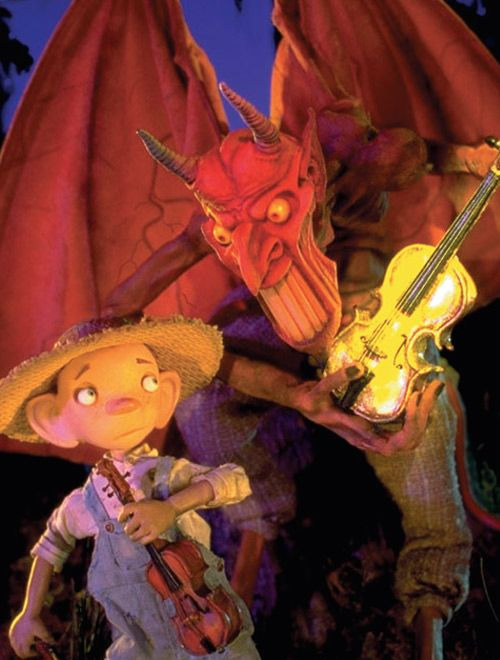
I think this is one of my favorite devils in any fiction ever, simply because of what a good sport he is. Like, there is really no denying that Johnny’s stupid little fiddle ditty about chickens or whatever sucks major ass, and yet Satan (who had moments before summoned up demonic hordes to rip out some Doom-esque metal for the contest) gave him the win and the golden fiddle. What a gracious guy! He’s a 9/10 for sure, though I still wish we knew how his rematch ended…
Chernabog:
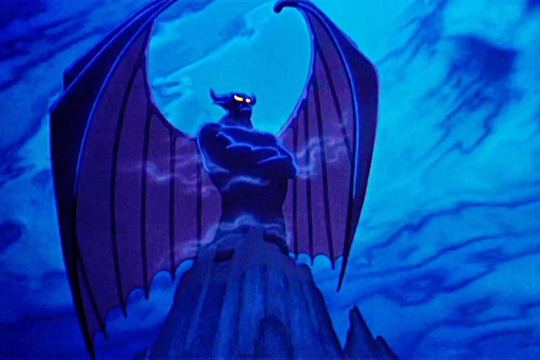
Chernabog technically doesn’t do anything evil, and he never says a word, and yet everything about him is framed as inherently sinister. It’s really no wonder Chernabog has become one of the most famous and beloved parts of Fantasia alongside Yen Sid and Sorcerer Mickey; he’s infinitely memorable, and really, how can he not be? He’s the devil in a Disney film, not played for laughs and instead made as nightmarishly terrifying as an ancient demon god should be. Everything about him oozes style, and every movement and gesture begets a personality that goes beyond words. Chernabog doesn’t need to speak to tell you that he is evil incarnate; you just know, on sight, that he is up to no good.
Quite frankly, the implications of Chernabog’s existence in the Disney canon are rather terrifying. Is he the one Maleficent called upon for power? Is he the one all the villains answer to? Do you think Frollo saw him after God smote him? And what exactly did he gain by attacking Sora at the end of Kingdom Hearts? All I know for sure is that Chernabog is a 10/10.
Lucifer (The Prophecy):
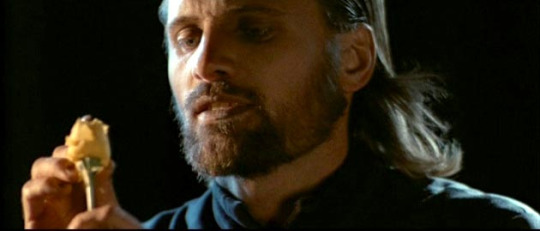
Viggo Mortensen has limited screentime, but in that time he manages to be incredibly creepy, misanthropic… and yet, also, on the side of good. Of course, he’s doing it entirely for self-serving reasons (he wants humanity around so he can make them suffer), but credit where credit is due. The man manages to steal a scene from under Christopher Walken, I think that’s worth a 10/10.
Satan (South Park):
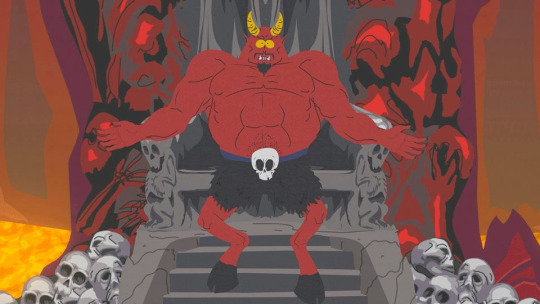
Portraying Satan as a sympathetic gay man was a pretty bold choice, and while he certainly does fall into some stereotypes, he’s not really painted as bad or morally wrong for being gay, and ends up more often than not being a good (if sometimes misguided) guy who just wants to live his life. Plus he gets a pretty sweet villain song, though technically it’s more of an “I want” song than anything. Ah well, a solid 8/10 for him is good.
Satan (Tenacious D):
youtube
It’s Dave Grohl as Satan competing in a rock-off against JB and KG. Literally everything about this is perfect, even if he’s only in the one scene. 10/10 for sure.
Robot Devil:
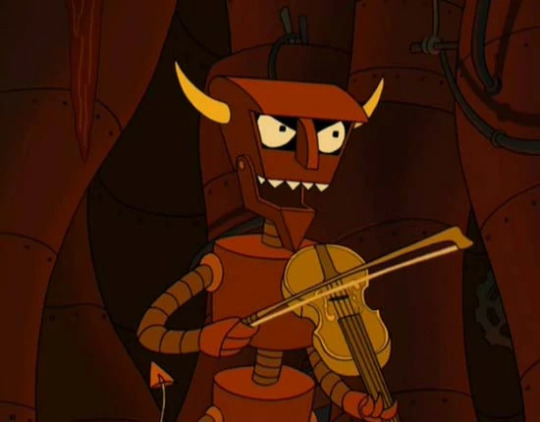
Futurama’s take on the devil is pretty hilarious and hammy, but then Futurama was always pretty on point. He’s a solid 8/10, because much like South Park’s devil he gets a fun little villain song with a guest apearance by the Beastie Boys, not to mention his numerous scams like when he stole Fry’s hands. He’s just a fun, hilarious asshole.
The Howling Man:
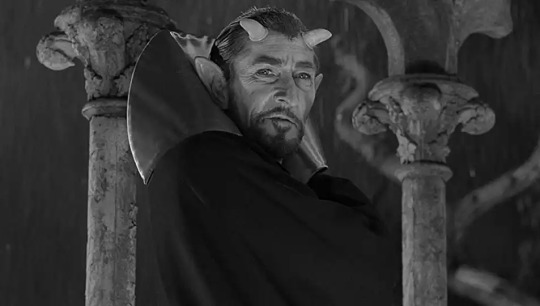
The Twilight Zone has many iconic episodes, and this one is absolutely one of them. While the devil is the big twist, that scene of him transforming as he walks between the pillars is absolutely iconic, and was even used by real-life villain Kevin Spacey in the big reveal of The Usual Suspects. This one is a 9/10 for sure, especially given the ending that implies this will all happen again (as per usual with the show).
The Darkness:

While he’s more devil-adjacent than anything and is more likely to be the son of Satan rather than the actual man himself, it’s hard not to give a shout-out to the big, buff demon played by Tim Curry in some of the most fantastic prosthetics and makeup you will ever see. He gets a 9/10 for the design alone, the facty he’s Tim Curry is icing on the cake.
18 notes
·
View notes
Photo

Oliver Stone’s ‘Natural Born Killers’ Is, More than Ever, the Spectacle of Our Time
Yet it has never gained true respectability.
Variety
|
Owen Gleiberman
“ Works of art that were once radical tend to find their cozy place in the cultural ecosystem. It’s almost funny to think that an audience ever booed “The Rite of Spring,” or that the Sex Pistols shocked people to their souls, or that museum patrons once stood in front of Jackson Pollock’s splatter paintings or Warhol’s soup cans and said, “But is it art?” In 1971, “A Clockwork Orange” was a scandal, but it quickly came to be thought of as a Kubrick classic.
Yet “Natural Born Killers,” a brazenly radical movie when it was first released, on August 26, 1994, has never lost its sting of audacity. It’s still dangerous, crazy-sick, luridly hypnotic, ripped from the id, and visionary. I loved the movie from the moment I saw it. It haunted me for weeks afterward, and over the next few years I saw it over and over again (probably 40 times), obsessed with the experience of it, the terrible lurching beauty of it, the spellbinding truth of it. It’s a film that has never left my system.
I’ve met a number of people who feel the way I do about “Natural Born Killers,” but I’ve also run across a great many people who don’t. The reaction has always been split between those I would call “Natural Born Killers” believers (they included, at the time, such influential critics as Roger Ebert and Stanley Kauffmann) and those who thumb their noses at what they consider to be an over-the-top spectacle of Oliver Stone “indulgence.” At the time of its release, it was said that the film was bombastic, gonzo for its own sake, pretentious as hell, and — of course — too violent. Too flippantly violent. In a way, “Natural Born Killers” was the “Moulin Rouge!” of shotgun-lovers-on-the-lam thrillers. Either you got onto its stylized high wire, its deliberate pornography of operatic overkill, or you thought it was trash.
The divide has never been resolved, and the movie has never gained true respectability. Which I think is a good thing. Some works of art need to remain outside the official system of canonical reverence. But if you go back and watch “Natural Born Killers” today, long after all the ’90s-version-of-film-Twitter chatter about it has faded, what you’ll see (or, at least, what I hope you’ll see) is that the movie summons a unique power that descends from the grandeur of its theme. Far more than, say, “The Matrix,” “Natural Born Killers” was the movie that glimpsed the looking glass we were passing through, the new psycho-metaphysical space we were living inside — the roller-coaster of images and advertisements, of entertainment and illusion, of demons that come up through fantasy and morph into daydreams, of vicarious violence that bleeds into real violence.
I’ve always found “Natural Born Killers” a nearly impossible movie to nail down in writing (it’s like trying to capture what music sounds like). Sure, it’s easy to summarize the tale of Mickey Knox (Woody Harrelson), a sloe-eyed drawling psycho in a blond ponytail, and his ragingly damaged bad-apple lover, Mallory (Juliette Lewis), the two of whom go on a killing spree that turns them into celebrities, like Bonnie and Clyde for the age of TMZ.
Yet it’s the moment-to-moment, shot-to-shot texture of the movie that transforms a two-dimensional story into a four-dimensional sensory X-ray. I took my best shot at writing about it in my 2016 memoir, “Movie Freak,” in which I said:
“The tingly audacity of ‘Natural Born Killers,’ and the addictive pleasure of watching it, begins with the perception that Mickey and Mallory experience not just their infamy but every moment of their lives as pop culture. Their lives are poured through the images they carry around in their heads. The two of them enact a heightened version of a world in which identity is increasingly becoming a murky, bundled fusion of true life and media fantasy. It works something like this: You are what you watch, which is what you want to be, which is what you think you are, which is what you really can be (yes, you can!), as long as you…believe.”
What form does this kind of belief take? It’s a word that applies, in equal measure, to the fan-geek hordes at Comic-Con; to the gun geeks who imagine themselves part of a larger “militia”; to the gamers and the dark-web conspiracy junkies; to the people who think that Donald Trump was qualified to be president because he pretended to be an imperious executive on TV. It applies to anyone who experiences the news as the world’s greatest reality show, or to the way that social media is called social media because it’s about people treating every facet of their lives as “media” — as a verité performance. Made just before the rise of the Internet, “Natural Born Killers” captured, and predicted, a society that turns reality itself into a nonstop channel surf, a simulacrum of the life we’re living. One of the film’s most brilliant sequences is a dystopian sitcom, with a vile fulminating Rodney Dangerfield, that depicts Mallory’s hellish home. It’s a dysfunctional nightmare reduced to TV, which is what allows Mallory to murder her way out of it.
“Natural Born Killers” took off from a script by Quentin Tarantino that got drastically rewritten (Tarantino received a story credit), though it provided the basic spine of the film’s evil-hipsters-on-the-run structure and kicky satirical ultraviolence. But there’s a reason that Tarantino didn’t like the finished film; it’s not, in the end, his sensibility. His vision is suffused with irony, whereas Oliver Stone directs “Natural Born Killers” as if he were making a documentary about a homicidal acid trip.
The patchwork of film stocks that Stone employs (black-and-white, glaring color, 8mm, grainy video) turns the movie into a volcanic multimedia dream-poem. And it’s no coincidence that those clashing visual textures are an elaboration of the style that Stone invented for “JFK,” a drama about political reality (the assassination of a president) that gets sucked into the vortex of media reality (the now-you-see-it-now-you-don’t mesmerization of the Zapruder film). “Natural Born Killers” pushes that dynamic several steps further, as Mickey and Mallory’s murder spree becomes a hall of mirrors that’s being televised inside their own heads. In 1967, the tagline for “Bonnie and Clyde” was “They’re young. They’re in love. And they kill people.” The tagline for “Natural Born Killers” should have been: “They kill people. So they’ll have something to watch.”
“Natural Born Killers” captures how our parasitical relationship to pop culture can magnify the cycle of violence. Yet that theme may be more dangerous now than it was in 1994. As a liberal who’s a staunch advocate of every gun-control measure conceivable, and would never think to “blame” a mass shooting on a piece of entertainment, I am nevertheless haunted by the possibility that half a century’s worth of insanely violent pop culture has had a collective numbing effect. In “Natural Born Killers,” a psychiatrist, played with diligent dryness by the comedian Steven Wright, gets interviewed on television about Mickey and Mallory, and his analysis is as follows: “Mickey and Mallory know the difference between right and wrong. They just don’t give a damn.”
That, to me, is one of the most resonant lines in all of movies, because what it’s describing now sounds chillingly close to too many of us. Sure, we all say that we care. But if you look at the actions, the judgments, the policies supported by millions of Americans, it seems increasingly clear that we’re turning into a society of people who know the difference between right and wrong, but just don’t give a damn.
Or maybe that’s too dark a thing to say. But the beauty, and brilliance, of “Natural Born Killers,” which draws on and radicalizes a tradition of movies (“Bonnie and Clyde,” “Badlands,” “Taxi Driver”) that deposit the audience directly into the souls of sociopaths, is that the film dares to ask us to ask ourselves what we’re made of. To ask whether we’ve removed life from reality by turning it into a spectacle of nonstop self-projection. To ask whether we’re now watching ourselves to death. “
-- I loved it when I saw it. I saw it once. It scared me. It was too real and too predictive, too foretelling. But brilliant. Scary brilliant. To see the parody of the sitcom is to live your present life, your past life, and realize a subtle and not so subtle horror coursing through our filtered vision every day.
23 notes
·
View notes
Text
Another week, another brand-new episode of Psycho Pass. I’m going to hold back and be all mysterious and stuff. Because that’s how I do. I definitely don’t blurt out exactly how I feel about a show in the very first line of every post and then there’s no point in reading the rest. Nuh-huh. No siree. I gots some restraint! Who do you take me for! So instead, Matt, how are you enjoying season 3 so far. It may just be 3 episodes in but as they are double length, it’s now longer than most movies!
Oh, so does that mean it’s my turn to blurt out my thoughts in a single sentence? Okay, um, err, this show is still as consistently excellent as I thought it was based on the previous two episodes! Oh no, I hope I’ll have something to write for the rest of the review now!
Is that so? Fascinating. I can see how you would think and/or feel that way! (I write my part first… I have no clue what Matt said at this point…
So let’s get right into it. First I just a few general comments on my part. I enjoy high stakes corruption stories and although that’s also what season 1 was, the fact that this allows us to look into the public face of Sybil a bit more, through the device of gubernatorial elections is a great angle in my opinion. Diving into what has to be extremely complex and unique politics of a Sybil controlled society has so much potential.
I had to look up what “gubernatorial” meant (we don’t have anything like that in Australia, so forgive my ignorance), but yes I think politics and the world of ‘Psycho Pass’ is a perfect fit.
I mean what powers do politicians even hold in such circumstances. Are elections largely a population suppression tactics. Something to keep the masses happy? If so, why are they so incredibly high stakes. Seems ridiculous to be going through all this for what amounts to a reality show (which might explain why both candidates are entertainers). So much potential!
What do you think?
I mean, if I know anything about politics and people its that ambitious people will always be ambitious and wanting to be ‘the best’ regardless of the world they live in–so even if politics amount to nothing more than a popularity contest without any real power or ability to change anything outside of Sybil’s system–people are still going to strive for that, people are going to kill for that even. We’ve seen time and time again in the real world that people do extreme things to get what they want, even if to ‘outsiders’ their goals seem ridiculous or pointless.
Yakusuji really surprised me as a character this week. For a second there I thought they were going with a “bad guy is bad” sort of characterization but then it all took a very sharp right turn! I still don’t know if his character is sincere or if it’s all a big act. Either way, I didn’t expect it and I like it! Maybe it’s my suspicious nature that leads me to think he’s less than sincere but Psycho Pass did teach me not to trust anyone!
He’s definitely an interesting character but the way his character ties into Enforcer Todoroki’s subplot makes for a compelling bit of character development. As for whether he’s ‘on the level’ I don’t buy it…
I did find the assault scene a bit blunt. Not as in too brutal (mind you I thought it was hilarious that someone could kick a skull in so hard as to actually make it explode!) but just a little too straight forward. At least that’s what I thought as I was watching it. In hindsight though, if this was a political machination and not just the random terrorist attack they are making it out to be on the surface, then this type of direct and flamboyant assault is exactly what would be the most effective!
Yeah I took it to be that they were being intentionally flashy, down to the attackers wearing the same clothes, I found it to be a very intimidating scene.
How does anyone in this universe manage to keep their hue clear? I was only watching those little holo assistant thingies pop up for a few minutes (like the old Clippy office assistant) and I already felt my urge to murder rise. I wouldn’t last a day if I had to deal with those things and keep my thoughts in check!
I loved the idea of someone being physically assaulted and then a little pop-up comes up warning them that they were receiving injuries in-line with someone being assaulted, it’s that kind of AI assistant mentality that makes me hate AI assistants like ‘Alexa’ and ‘Siri’ all the more (but that’s a rant for another day).
As our heroes were chasing the attackers down, we got some surprising bit of universe building and musing on the dual nature of justice and law. One of my very favourite lines from the first season was said in a similar context. As Akane was chasing down criminals she said something to the effect that there’s a misconception that laws are there to protect people but it’s really up to people to protect the laws. I love that idea. It really epitomized Akane’s character and the fact that that’s what’s going through her mind in a high-pressure situation was just perfect.
We got something similar this week with Arata capping off a chase explaining that even in a Sybil controlled society it is imperative to exercise human judgement “that’s why dominators have triggers”. It’s a great line! And one that solidifies Arata’s devotion to ideals rather than establishments.
I’m glad you brought it up, that line really stood out to me too, the importance of the human aspect in an (at times) inhumane system.
Matt, you mentioned last week that you felt the writers of Psycho Pass season 3 had gotten around to reading old US news, it seems that they’ve moved on to more recent fare as the general depiction of the mudslinging politics does seem very familiar to what has been happening not too far south from my own home in the past few years!
Immigration’s a tricky thing, ain’t it?
Although, aside from the winky topical references, it does make a lot of sense that a society as portrayed in Psycho Pass would be particularly xenophobic. To be honest, I was really surprised they even had large scale immigration. I figured the country would have been largely sealed off!
So far, the themes of racial/cultural tension are handled a little naively and way too simplified for my tastes. However, I do realize that with everything going on in this narrative, you got to take some shortcuts.
I suppose there’s still time for a more nuanced discussion on immigration from this show, I imagine someone like you Irina, an immigrant yourself, would have a lot more to say on the subject than most people?
What did you think of Haruki Enomyia? I’m asking cause I have no clue what to make of them.
Difficult to say, for a second I thought they might be setting them up as a bigger villain for this story but I think they’re probably going to end up just another pawn in the bigger game being played. I think they were more just here to give us an idea of what kind of life Kazumichi had in the slums before joining the force. Though I think him just walking around the town with Arata did that well enough.
Am I the only one who noticed all the food in this episode? Maybe I was just hungry, but everything looked delicious!
C’mon Irina, all anime food looks delicious!
Ok back to more serious stuff, we got some very decent character-building backstory for both Kei and Arata. Now normally, this would not be my thing. It was delivered in straight exposition and boy oh boy was it all tragic! Taken independently, both of their backgrounds would have had me gently rolling my eyes and moving on without a second thought. Oh my, an anime protag with a tragic backstory! But it’s in how these stories intertwine to create such a bizarre picture of their relationship that brings the whole thing to a higher level.
It’s kind of interesting that they chose to more or less have our entire supporting cast learn this complicated backstory at the same time via the expositional method you mentioned. On the one hand I guess it helps to have everyone on the same page with their history but it makes me wonder if it was done for a more specific reason. Like one of the Enforcers using this information against our dynamic duo or the opposite and it puts more faith in them and brings closer as a team–who can say for sure?
In fact, the peculiar dynamic between Kei and Arata is truly fascinating and so far, a strong point of the season for me.
Agreed.
A few little random thoughts:
I quite like both the OP and ED. I like the visuals in the OP better, in fact, I like them a lot, but I prefer the ED song!
The interiors are really beautiful this season. I’m not so taken by the architecture, but room designs consistently catch my eye.
Also, I didn’t know where to fit it in the review, but I liked the statement that acting weak releases cortisol making you feel more relaxed. The behavioural neuroscience angle is one I like a lot and I hope they develop it more as Psycho Pass is the perfect universe to explore this in.
I thought it was interesting–if briefly mentioned–but I have to wonder if it was just the writer showing off some fancy things he learned on wikipedia and wanting to put it into the show (okay that was a bit catty of me, apologies to the writer of Psycho Pass).
Oh I guess I should finally admit it. I really liked this episode. More than the last. So far, I think the writing may be a touch weaker than I had hoped. There’s a lot of slightly clumsy exposition. But I’m also starting to see the foundations of a potentially fascinating story with some very intriguing dynamics. I’m excited. When the episode ended I was both surprised by how quickly it had gone by and a little bummed I couldn’t watch the next one right away!
I have to agree (we seem to agreeing a lot this time!) our new characters feel like they’re living up to the potential of this show’s world while adding interesting things to it too. Political corruption, a shadow organisation called ‘Bifrost’ pulling the strings (cool name by the way) plus all the internal machinations at the various levels of law enforcement and interpersonal relationships too makes for a rich and compelling tapestry. If you’re a person who adheres to the 3 episode rule and you haven’t given this show a chance yet then 3 excellent episodes in a row should be proof enough that Psycho Pass is back and firing on all cylinders!
Psycho Pass s3 ep3 – Tensions Flare Another week, another brand-new episode of Psycho Pass. I’m going to hold back and be all mysterious and stuff.
10 notes
·
View notes
Text
11/15/17
This is something I wrote in my notes about Don Hertzfeldt, emotion, and inspiration while sitting in a parking lot, a month ago if I have the date right. Usually I feel the need to make art or write out some big thing as part of a project about this stuff, but I was feeling overwhelmed and my friend Robert Tate suggested I just write about it, so I did, and it helped me. I’m not editing it at all, but I’m putting it here just so I have it somewhere where people can know this about me and know me a little more (if anyone is left on Tumblr idk I haven’t been on here in a bit). I’m sorry about the language if you’re someone I need to be sorry about the language to, but also these were just my own thoughts and I didn’t really have the intention of sharing it. Also, I’m sorry if you are Don Hertzfeldt and you are reading this because it would probably be really weird to read this about yourself, I’m not like a psycho fan, I don’t think, just scared and inspired.
Yesterday, in the midst of sitting in the Bargain Outlet parking lot in a controlled state of stress-paralysis, I discovered that Don Hertzfeldt has been keeping an online journal since 1999. I was on my computer, desperately, trying to decide once and for all whether to head home to be with my family, head north to go to Mt. Tam and Pt. Reyes, head way north to Lost Beach and the Redwoods, head east to Sacramento, or head south through Palo Alto…. toward home as well, I guess. I don’t know exactly how I ended up on Don Hertzfeldt.
I discovered his journal and I couldn’t believe how many things it did to me. He is a figure I have built up in my head to be pretty big. I have ideas about what kind of person he is, from watching his films, in kind of a cycle- I tend to do that with artists who inspire me. His films inform my idea of who he is as a person, which in turn inform my idea of his films. This was one of those amazing moments where all the sudden I had access to his actual ideas, and they exactly fit with my idea of who he is as a person, except even better, if only because they were real. I was overwhelmed by inspiration about artistic integrity and the sadness of life and tying the two together.
Somewhere in all of this, it became relevant for me to watch a 2 minute short film he made as an intro for The Simpsons. It almost made me cry.
I later tweeted a string of tweets; “every time I feel like I might cry the voice in the back of my head goes "yes! you're crying! you're not an emotionless robot look how much you're FEELING!" and then I never cry.” and then: “anyway, this most recent occasion was from watching The Simpsons Travel Into The Future Couch Gag by @donhertzfeldt, I SERIOUSLY HAVE NO IDEA WHY I haven't even watched that much Simpsons.”
And this was all true except the part where I said I SERIOUSLY HAVE NO IDEA WHY, because I have a lot of ideas why. And it also made me think of some interesting things about how we portray ourselves on social media. I tweeted that to be funny and honest, and, I think, it was funny and honest. But it was also cute, and kind of skirting around what I actually was trying to acknowledge.
I very, very rarely cry. Maybe 5 times since starting college? Definitely no more than 10. And it makes me feel weird that I never cry, because it’s not that I’m just that chill of a person. I have very little chill, I care constantly, and about nearly everything. The reason it makes me feel weird is because I feel like I am never fully in an experience, a feeling, or a moment. I feel one thing, and then I think about why I’m feeling that, whether or not I really am, what that means, etc. I laugh and then I immediately think “was that even funny? am I even happy or having fun?” Crying, for me, means being totally overwhelmed by emotion, good or bad. I want to be totally overwhelmed by emotion, good and bad, but I rarely am. There is always the removed, disconnected, worried part of me questioning every experience, wondering why in the fuck life is even worth going through anyway.
So yeah, the tweet was funny, but that’s what I was getting at. I never cry because I am never that present in a moment. When I am for a split second, my brain thinks about it, and takes me out of fully experiencing the moment. It’s weird, but it’s how I am. In my best, and my worst, and all of my MOSTS.
Second, I could figure out why. I was reading things about how Don Hertzfeldt thinks- his random thoughts, his ideas, his dreams (literal dreams), and his integrity as an artist. How he refuses to do commercials, refuses to give almost any of his control over his own art to anyone else. The guy DISTRIBUTES his own work. That’s crazy. And to see that, and then see this crazy fucked up Simpsons short, and see how it actually had the power to move me in the span of about 30 seconds, and it actually implied some pretty deep shit, and aired on national television, made me proud, and encouraged, and yeah, pretty emotional. And on top of that, the short just moved me. It was an actually beautiful depiction of society devolved, implying a winking, dark joke about the show, with a beautiful segment remembering the actual connections they used to have- ending with, again, a winking dark joke. In 2 minutes. Later I found his journal entry about it, and he had almost no input or editing from the Simpsons- they just let him do what he wanted, and that’s what he did, and it’s amazing to me. It moved me, and the fact that he made it moved me, and it made me want to cry. I watched it some more times and it held.
Today, I continued reading his journal, and and AMA he did, and other Hertzfeldt things, and I am overwhelmingly inspired. I can’t believe that his thoughts imply all the things I hoped about him as an artist, and I can’t believe he, who is semi-notoriously removed from the pop culture/interview/etc world, has given us access to his real life and thoughts like this.
I found out that he isn’t really into animation or cartoons besides the fact that that’s what he literally spends his whole life making. They were just the form that was best to convey his stories and interests and the way he felt most comfortable working.
I can’t say how huge that is- I have already written before that he serves as a symbol to me of making art on your own terms- that he has made me worry less about meeting industry standards, curating the exact set of tools I’m supposed to, and instead has just made me want to focus on getting good. And I worry a lot about art in the physical, drawing sense, being my main set of tools to communicate with. I worry because this is not the kind of art that has most frequently or greatly impacted me. Movies and music, and sometimes books, and the words contained in all three are what mean the most to me- what I feel drawn to, fill my thoughts with, and to an extent, build my life around. I worry that I am being lazy or safe in pursuing art, that I am just doing it because I know I am semi good at it, that I will never fulfill my potential because I’m not trying to. That I don’t really have anything to say with artwork in that medium. and that i just use it to mask my words and make me less embarrassed about them, legitimize them. But drawing is what feels comfortable to me, what I know how to do, and gives me total control of what I’m doing. (I think that’s some of the draw for Don as well, he is branching out now, but traditionally has retained total control over his work by working in this medium). So to see one of my biggest inspirations working in a medium he isn’t necessarily most impacted or obsessed with, but because it’s what he feels drawn to, someone who has already inspired me to be like that without knowing that’s how he is- that’s a pretty big deal.
The other thing that has stood out to me is how humble his lifestyle and opinion of his own work is. He obviously is proud of it, but doesn’t think he’s great, and even if he does, seems to refuse to actively think it. I think for a long time I’ve expected to eventually transform into the pure-art-version of myself, for my ideas to all the sudden be all amazing and inspired and exist on a higher level than my fellow people, like I like to think some of my other heroes do. And I think reading his journals is helping to remind me that that is not how this works, and encourage me that is okay. It’s kind of awesome, actually, to think that I could do work now in my not nearly “ready” state that could mean something to people- I don’t have to get to a certain spot first. It’s just working, and sometimes the work works and sometimes it doesn’t but it’s just working and you have to believe in why you’re doing it, but that’s it. You don’t unlock some magic ability. And traditionally that has been terrifying to me, but somehow it’s starting to feel encouraging instead? Similarly to how It’s Such A Beautiful Day shifted from a terrifying, yet awe-inspiring piece of art in my life to an encouraging yet awe-inspiring film. It’s crazy to see my perspective shift in places that I formerly thought I, or life, had to. But it was actually just the way I was looking at things.
Anyway, I feel that I might end up owing a lot to Don Hertzfeldt. I am so happy he is out there and making art, and encouraged by his mind and the way he uses it. If I could follow in his footsteps even a little I will be happy.
Also, his work ethic is like a million times better than mine, so I better get the fuck to it.
(Here is a link to the couch gag if you are interested: https://www.youtube.com/watch?v=m78gYyTrG7Y)
#i am simpson#i am simpson i am simpson#all animals can scream#i will always love you homar#don hertzfeldt#personal#inspiration#artistic integrity
11 notes
·
View notes
Text
Mob Psycho 100 Season 2

Hello and welcome to the first outright perfect episode of anime of 2019! Mob Psycho 100 knocked it out of the park this week in every respect, so let’s just jump right in!
Right off the bat, Bones is out in full force animation wise. Everything about this episode, visually, was fantastic. Even in drab, rain-slick scenes they found a way to introduce color to a drab landscape. And that isn’t even mentioning the wholly unique perspectives or styles for animation. Take for instance the straight up street fighter/fighting game reference. Done entirely in Mob Psycho’s style, it was a fantastic gag. Then there was one of my favorite styles, which only appears in Mob Psycho, the paint on glass effects. For depicting other worldly spirits, I think it does a fantastic job of showing that etherealness. Add on to all of this the sheer amount of sakuga throughout the episode, from Dimple jumping between trees, to the flowing sludge of the monster spirit, and you have a feast for the eyes. 2 weeks in and Bones has already won Animation. Wow.
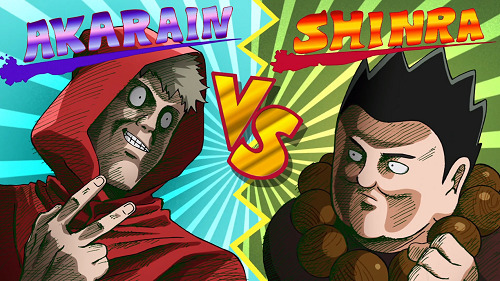
Now, onto the actual story content of the episode. Normally we would be entering the Urban Legend arc for the series, however parts of this were already covered in the first season. For instance, the exorcism at the girls highschool and the Scarecrow from the first episode were originally part of this arc. I think the way Mob Psycho handled those was still good, the Scarecrow was a good introduction and it didn’t hurt the series at all. It just means this arc won’t be as long as you might think, probably ending next episode. That isn’t to say it won’t be worthwhile though, if this episode was anything to go by. In a single episode Mob Psycho established a new psychic, set him up as a fraud only to reveal him as an upstanding citizen combatting spirits. Walking through his character in a single 22 minute episode. Lovely.
His whole “side story”, though really Mob and Reigan are the side story here, was great. I loved how it started with nothing paranormal at all, but hinting it might be. Then revealing it to be just a streaker that could be caught without powers. Until it all culminates in a big supernatural fight with a legitimate urban legend. Each of these with some sort of commentary on society, as the Dragger is fueled by peoples belief and cannot be fought by those who fear it. ONE (the author for Mob Psycho and One Punch Man) really is a great writer. He hits on these topics close to society or personal experiences, but wraps them in a supernatural shell. Removing it just enough from reality that it doesn’t become a direct critique of modern society, but still planting those ideas in the viewers heads.

Take the streaker for example. What started as a simple ass gag in a raincoat quickly turned into a dark dive into a criminals mind. Describing the mentality of the criminals high. How he gets off not only on revealing himself, but on everyone knowing he exists. A sort of perverse celebrity status. We see this in real life all the time with mass murderers, bombers and such. Who want to be known, want their message to get spread by the news media. It was all very dark, yet because of the previous setup with the childrens park, it worked well. Yeah, it might have jumped from jokey to serious a bit quickly. But I think Mob Psycho’s humor, which permeates everything about it, softened the blow a bit.
Meanwhile Mob and Reigan are off on their “side” adventure. What I love about this is that it reinforces Reigans character. We constantly see he is a con-artist, praying on people’s idiocy or troubles. Yet we also see he does legitimately care. Giving them peace of mind, or going out of his way to clean up an old man’s dog. To Reigan no job is to dirty or undesirable to do, so long as he gets paid and someone is happy. In fact we learn from Shinra that Reigan is charging far below the standard psychic price. Most likely it’s unintentional, if he thought he could get more he would go for it. But it reinforces that Reigan is not a prideful man, just one trying to get by on the only skill he really has. His maxed out charisma stat.

As far as the Dragger scenes go, I loved them.The whole sequence was animated fantastically, showing that no one can match Bones when they are their best. So many interesting angles, rotating shots and unbroken cuts. From the closeups of her face to the flowing sludge of the second half, Bones was here in full force. I also enjoyed the subtler aspects of the scene. Such as the water slowly rising up their feet, as the trees sunk behind them. The use of mud splashing against trees and landing in the shape of a screaming face. The tiny dolls themselves and their use in the fight. Simply put, Mob Psychois probably the best animated of the season and I fully expect it to compete for best of the year.
There was also the narrative aspect of the fight that was interesting. Last week Mob decided to start caring more about his emotions and such. This week tackles his social ineptitude and how breaking yourself off from fads isn’t necessarily a bad thing. It was Mob’s detachment, his individuality, that allowed him to face the dragger. He doesn’t care much what other people think, so the fads and pop culture never really took root in his mind. That of course has its downsides, it hurts his social prospects. But Mob Psycho also shows how it has its perks. Giving him the ability to think outside the box, not tied down by social conventions. To drive this home, right after this, Reigan talks to Mob about paying lip-service in the adult world. At least feigning knowledge of pop-culture, though he did it by yelling.
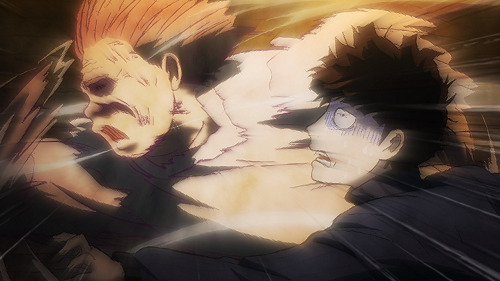
The slowly growing rift between Reigan and Mob aside, the last bit of the episode was the Dashing Granny. God this was a funny. This grandma gag was better animated than some full on series. All for a joke. In other series, I always reference the Simpsons and their layered jokes when discussing comedy. This is because I think the early Simpsons has some of the most clever comedic timing and writing on TV. Here, we see Mob Psycho displaying the same kind of layering. The joke starts with the running grandma. Then it becomes less of a joke and more a “serious threat” since it can’t be exorcised. Mob can’t run for shit, but the first punchline hits as she just ignores him and runs by in an over the top fashion. Only to throw in one more punchline with Mob’s Body Improvement Club. Layers. Like an onion. Fantastic.
All in all, Mob Psycho is now 2 for 2 on fantastic episodes. They have so much going for them, so many layers in every aspect. The animation is a step above everything else of the season. The narrative is deep and the jokes are snappy. Clearly a lot of love and care has been put into this series. It shows in every frame. If I had to pick something to nitpick about, it might be the sound design/VA’s, but that is really stretching it. Like, nitpick to the point of absurdity, stretching it. I like both and it’s only rarely that something sounds funny to me. So with that all said, I think it safe to safe, Mob Psycho is fantastic and you should watch it.
1 note
·
View note
Text
American Psycho: A review for people who are scared to read it.
I have a theory that American Psycho was something of a literary template for The Curious Incident of the Dog in the Night-Time <cue howls of indignation>. Let me finish – I know that psychopathy is not autism, although the conditions can share some personality similarities, and I know that there is nothing more stigmatising and incorrect than to conflate the two, but from a textual point of view, let’s consider this for a second: both are written from a first-person perspective, narrated by characters who categorise the world around them in meticulous analytical detail. Both characters spend a lot of time explicitly explaining their actions to the viewer in a clinical, methodical way. Both novels devote entire chapters to musings on pop culture. Both novels depict their characters’ struggle to interact with the world around them as a result of their conditions. Obviously I don’t think that Mark Haddon sat down to read American Psycho and thought that he could write Patrick Batman-lite, but there is an interesting familiarity in reading American Psycho in terms of how it’s structured, and in how Bateman details his world. So perhaps my ‘theory’ is more of an interesting coincidence, but it stands that American Psycho is, at its core, a fantastic character study of a man who feels little connection to the world around him, and a vicious skewering of conspicuous consumerism. It has also been hugely misunderstood and misinterpreted by critics and the public alike for the entirety of its existence.
American Psycho is a 1991 novel by Bret Easton Ellis, centred around the obscenely wealthy New York yuppie, Patrick Bateman; a self-confessed ‘fucking evil psychopath’. It follows his life over a period of a couple of years (although the amount of time that passes between the various scenes is vague at best) as Bateman guides us through whichever experiences he chooses to show us. Now I know what you’ve heard, and don’t get the wrong idea - the majority of the novel simply depicts the superficial banality of Patrick’s life - vacuous conversations with his friends over dinner at expensive restaurants (or over drinks and cocaine at exclusive clubs), detailed dissections of certain musical icons, meticulous descriptions of the clothes and things owned by the people around him, and his liasons with various women in his social circle as they sleep, eat, drink, and do drugs with each other without any respect for established ‘relationships’. And that’s ‘relationships’ in inverted commas, because these people are self-centred-ness made manifest. Consumed by their obsessions with money and possessions, all of the characters seem incapable, undesiring, even, of forming genuine emotional connections to anyone around them. Their loyalties to their friends are tenuous, to their lovers even more so, and their conversations revolve almost entirely around fashion etiquette, which restaurant is the most chic (certainly not the same one that they’ve eaten at that one time in the last two weeks), and which piece of meat (apologies, ‘woman’) they’d like to have sex with.
But the novel is controversial for a reason, and there are certain parts of American Psycho that contain some of the most repellent and detestable things I have ever read. There was more than one occasion where I simply had to put the book down, cursing internally and aloud the lack of artistic merit and the pure sadism of these sections and the actions contained within. But it also stands true that the more reactionary among us will read these parts, or hear of them, and damn the book as misogynistic torture-porn, and will miss the point entirely. I can’t excuse the scenes of violence, and I still struggle to understand why they must exist in such a way. Perhaps they’re there to make the reader feel ashamed – to lure them into a trap with promises of titillation and taboo bloodlust, and then horrify us into self-reflection? But to boil the purpose of the novel down to these moments is far too simplistic. The characters and their actions are misogynistic, yes, because American Psycho is an apocalyptic look at America’s lust for wealth and reverence of the god Economy, forsaking all other virtues along the way. It is money as a substitute for masculinity. These men are disgusting, and their actions are disgusting, but at the centre of every single one of them lies nothing of value. They are pathetic - empty shells existing only for an induced high, for the hollow prestige of things that serve no purpose other than to be gaudy and far-too-expensive. They repeatedly order high-priced drinks and meals that they don’t touch and entertain themselves by abusing and belittling homeless people in the street. They’re pitiful, and prey on the equally vacuous women that surround them, bouncing from mate to mate, from drug to drug. American Psycho forces the reader to take a look at an unvarnished and extrapolated depiction of what corporate America desires most, and absolutely savages it in the process. The novel won’t let you relax - the rate of murders and the horror of the descriptions escalate in its latter half and it certainly makes it a difficult slog to the end, and just as you think you’re becoming complacent towards the nastiness, it ups the ante and leaves you feeling angry and repulsed all over again, but the truth is that other 90% of its 380-odd pages are really just filled with meticulous descriptions of things. To this end, and spoiler-free, it all feels a little pointless upon its conclusion. But perhaps that’s the point? It revisits a scenario that it has portrayed a dozen times before, and the text could be word-for-word copied from any one of a number of other points earlier and it really feels a little boring, a little underwhelming. And it should, because no matter the lengths Patrick goes to in order to stimulate himself, to make himself feel something – anything – other than boredom and disgust, neither he nor his friends can escape the empty repetitiveness of their lives.
If there were a narrative, it would be that we follow Patrick’s unravelling sanity as time progresses. He admits within the first few pages that he is a psychopath, but for a long time we only get hints here and there of his deviant actions. Then, one by one, and almost too casually, we are introduced to his disconnections from reality, and then his murders. They come without warning and unpredictably. He begins to hallucinate more vividly and frequently, and the novel reaches a point where one can doubt almost everything he says. At one point he describes in a rambling stream-of-consciousness his deranged ravings in the streets as he goes shopping one afternoon, assaulting people in public and screaming and banging his briefcase along a wall, eating his melting hair-gel and standing for an hour in a trance in a shop. At another point much later on he leads police on a chase through the city as he murders at will and blows up police cars. Whether or not he actually performs any of these actions is left almost entirely uncertain, and all confessions of his crimes are misheard or taken by others as jokes. He kills an associate and claims to drag the corpse through the street in a sleeping bag; he is even investigated for the man’s disappearance by a private detective, but then months later someone claims to have lunched with the man only a short time prior. Did Bateman really kill the man, or was it a hallucination? One can’t ever know, as all his friends look the same and they all frequently mistake one-another for other people; in this very conversation, the person who claims to have lunched with the dead man has mistaken Bateman for someone else. This is the level of unreliability that the novel operates on. The most stark degradation of his lifestyle is exhibited in the way his home life changes from a militaristic adherence to his beauty regimen to literally eating viscera on the floor of a blood-soaked apartment, and this is all interesting enough to read until we are jerked back abruptly to another table at another restaurant with another fancy meal and another asinine conversation.
Patrick Bateman’s life is hell. His environment is affluent, but it is hell. He knows this, and yet he wouldn’t tolerate the idea of another way of life as he’s so enslaved by his own mental state that he barely even realises that he hates everything about it. Easton Ellis takes us through this hell, bludgeoning us with mundanity and violence alike, until we understand that what Patrick Bateman has is not something worth dreaming of, that America is sick and Wall Street’s unfettered lust for money is a blight, a cancer. It’s at times sickening, at times humourous, and at times rather tedious, and that’s the point. You aren’t meant to read this novel and think ‘damn, I’d like some of that’. You’re meant to feel disgusted and kind of bored. You’re meant to see this extreme depiction of an affluent life it for all that it is, and all that it isn’t. The memories of the abhorrent actions fade surprisingly quickly, given the horror they invoke, which is the only reason they are bearable, and I’m not sure that it’s good for the sanity to read this novel repeatedly, but it is certainly one of a kind, and one of the most savage indictments of greed-soaked materialism ever put to paper.
0 notes
Text
Psycho Analysis: Count Dracula
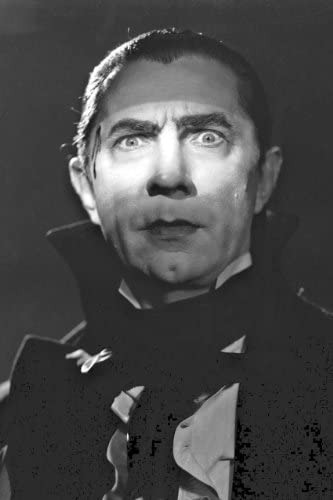
(WARNING! This analysis contains SPOILERS!)
So, in all my time doing Psycho Analysis, there have been a few villainous characters that, while extremely obvious, have such large and daunting scopes that it seems a bit scary to think I could accurately analyze them. Characters like Disney’s Pete or Bowser come to mind. Both are obvious 11s, but where to even begin with them? And that is a similar problem I faced with the villain who is arguably the single most important foe to ever grace fiction: Count Dracula.
How on Earth is one supposed to talk about a character who has spanned so much media and has remained an enduring fixture of pop culture for over a century? The guy has been in movies, comics, books, video games, plays, cartoons, musicals, songs… and he hasn’t even been a villain in all of them! How does one talk about such a villain with such a broad, all-encompassing scope?
The obvious answer is, of course, to talk about him in a broad sense and how he has affected culture, of course! This one’s going to be a little different than usual since I’m focusing more on the concept of Dracula than one single version, so there’s a lot of Dracula’s to go over here:
Performance: Throughout the years, Dracula has had many actors take a shot at him, though I think the finest takes are courtesy of Bela Lugosi and Christopher Lee. The former is basically what cemented Dracula as a sexy, Gothic horror icon, changing the far less attractive man from the book into a seductive monster that would color numerous adaptations after. Lee’s take brings the sexy, but is also far more violent and monstrous, mostly because Hammer horror films were all about that bright red blood, so gotta have someone spill it all!

If you’re looking for more flamboyant, hammy Draculas, Richard Roxbourg of Van Helsing and Duncan Regehr of The Monster Squad have you covered, playing Dracula at his most deliciously, monstrously evil. However, the hammiest (and thus most amazing) Dracula was Michael Guinn’s take in Symphony of the Night, with the entire opening exchange between him and Richter Belmont being a testament to the joys of chewing the scenery.

More comedic takes on Dracula have popped up over the years, with the most notable ones being Adam Sandler’s lovable, fatherly take on the character in the Hotel Transylvania films and Phil LaMarr’s performance on Billy and Mandy, where he plays a ridiculous, possibly senile version of Dracula who is abrasive and hilarious in equal measure.

Basically, when it comes to Dracula, you can easily find any sort of performance to suit your needs and give you what you’re looking for.
Best Scene: Over the years, Dracula has had a great many fantastic moments under his belt, so many fantastic scenes and boss battles… but for my money, the single greatest moment Dracula has ever been in is the opening battle of Symphony of the Night. Just watch this cheesy melodrama unfold and try and disagree with me:
youtube
Though, of course, his death in the animated series sure is a contender:
youtube
Best Quote: From the above scene, we have “What is a man? A miserable little pile of secrets!” among moany other meme-worthy bits of dialogue from Dracula.
On the subject of Castlevania, from the TV show we have Dracula at his most tragic and pitiable, especially when he delivers these fantastically tragic lines like “ It's your room... My boy... I'm- I'm killing my boy... Lisa... I'm killing our boy. We painted this room. We... made these toys. It's our boy, Lisa... your greatest gift to me... and I'm killing him. I must already be dead.” and “Your greatest gift to me... and I'm killing him." as he does battle with his son, Alucard.
Then of course, we have the legendary moment from The Monster Squad where Dracula drops any pretense and starts strangling a little girl, screaming in her face "Give me the amulet, you bitch!" It’s so deliciously, horrendously evil!
Final Thoughts & Score: It’s very strange to think of how much all of fiction owes Dracula. The original book invented a lot of traits (the lack of reflection being one) and popularized others (such as shapeshifting and weakness to garlic), but at the same time also predates a lot of things modern vampire fiction takes for granted. The Dracula of the book has no weakness to sunlight and gets younger as he drinks blood, starting as an old man; in fact, Dracula in the book is entirely lacking in the Gothic sex appeal that almost every adaptation of the character after would give him. He was also not very seductive, instead outright attacking women if he wasn’t hypnotizing them. Hell, he wasn’t even explicitly Vlad the Impaler in the books!
More than any other villain I’ve covered so far, Dracula is truly deserving of an 11/10. Even Count Orlok owes him a debt, seeing as Nosferatu was just a blatant ripoff. Hell, aside from villains from old mythology, I don’t think any villain can lay claim to the sort of scope Dracula has, having forever altered vampire fiction even as certain elements of him become lost in translation.
But what of some of his other incarnations over the years? How do they fare in terms of score? Well, I’m certainly not going to be incredibly thorough and list every Dracula ever, but here are a few I’ve encountered:
Obviously it’s unfair to give the Bela Lugosi incarnation anything less than an 11/10, mainly because this is the Dracula who pretty much inspired most other interpretations of Dracula after him. He’s suave, Gothic, attractive in that dark and mysterious way… it’s no wonder Lugosi’s Dracula became such an iconic fixture of cinema. Then we have the other classic Dracula, Christopher Lee’s take. I think he’s only a 10/10 because I feel like Lee’s tenure is a bit more overlooked and Lugosi tends to supplant him in terms of iconic status.
Castlevania as a franchise is specifically built qround defeating Dracula as the heroic Belmont clan or some adjacent vampire hunter. So you’d better hope that the big bad and master of the magical castle the game takes place in is impressive, right? Well he most certainly is; while he’s not completely fleshed out in every appearance he has some, like his iconic portrayal in Symphony of the Night, really help sell the idea this incarnation of Dracula is a rather tragic villain, though at other times in the series he seems to revel in being a monster far more than that interpretation would allow. Notably, the Castlevania show went with the more tragic approach to great effect, with Graham McTavish delivering a fantastic performance that swings from being genuinely terrifying to hauntingly emotional (just watch the scene where he breaks down upon fighting Alucard and realizing he’s killing his own son). Both game (in a broad sense) and show Dracula get a 10/10, for different reasons.

Duncan Regehr portrayed the Dracula in The Monster Squad, and it is quite obvious he’s having a hell of a time. He’s just wonderfully hammy, and he might be one of the most evil Draculas ever seeing how he called a little girl a bitch and tried to slaughter children with dynamite. This one’s a 9/10 for sure. I honestly think he’s the best take on the character, but his movie is sadly too obscure to really give him that push to being a truly iconic portrayal. He just captures the menace and charisma of Dracula so well, it’s a shame more people don’t know about him.

Van Helsing had a Dracula, played to hammy perfection by Richard Roxburgh. Say what you will about the rest of the film, but any Dracula movie that features evil bat monster Dracula fighting fallen angel werewolf Hugh Jackman in a battle to the death over Frankenstein’s atomic heart is worth at least an 8/10. For a more minor role, we have the Dracula who appeared in the blaxploitation classic Blacula. While he only appears for a bit at the start, long enough to curse an African prince with vampirism and dub him “Blacula,” this Dracula firmly cements himself as one of the most evil Draculas ever, gleefully participating in the slave trade. I believe that’s another 8/10 right there. On a related note, Blacula serves as a chief inspiration to the Billy and Mandy incarnation of Dracula, who is a cranky old black man with a big mustache and lots of sass (in fact, he’s accidentally closer to the original book’s depiction than most other Draculas). Sadly, as a more neutral chaotic comedic figure, I can’t give him a rating, but boy is he a riot.

Scooby-Doo and the Reluctant Werewolf features a more comedic and zany Dracula, one who participates in some good-old-fashioned Wacky Races cheating in an attempt to keep Shaggy as a werewolf forever. He’s mostly amusing for a oneshot villain, so I’d say 7/10 is fair. Speaking of oneshot villains, Dracula also showed up in an animated straight to video movie for The Batman, where he did things such as turn Joker into a vampire and get killed by Batman. He’s probably a 7/10 as well.

And then there are all the heroic takes on Dracula, such as the version from Dracula Untold or the “overbearing but endearing father” take on the character from the Hotel Transylvania movies (though that rap Adam Sandler does at the end of the first movie is pretty heinous).
youtube
And this is not an extensive list by any means. There are so many Draculas I haven’t watched yet, so many different takes I haven’t read the adventures of. And that, I think, is what makes Dracula such a great villain. He is a character who any writer can bend and shape to fit a plot, a villain who can serve almost any purpose and who can fit in almost any fantasy story imaginable. Dracula is incredibly versatile, and whenever he shows up in a work, things almost always get better for a bit. And keep in mind, this is a character who has been around since the year 1897, and yet he is still a household name that even people who have never read the books or seen the movies can accurately describe and recognize.
Is Count Dracula the greatest villain in all of human history? It’s debatable for sure, but I don’t think there’s any denying he’s up there considering his scope and influence and how he helped mold modern vampire fiction into what it is today. If nothing else, Dracula is still wildly influential.
#Psycho Analysis#Dracula#Count Dracula#The Monster Squad#Bram Stoker#Van Helsing#Hammer#Christopher Lee#Bela Lugosi#Adam Sandler#Hotel Transylvania
18 notes
·
View notes
Text
Psycho Analysis: Fu Manchu

(WARNING! This analysis contains DISCUSSIONS OF OUTDATED RACIST STEREOTYPES! This analysis does not support or condone such things whatsoever and merely is here to analyze the cultural impact of the character!)
"Imagine a person, tall, lean, and feline, high-shouldered, with a brow like Shakespeare and a face like Satan, a close-shaven skull, and long, magnetic eyes of the true cat-green. Invest him with all the cruel cunning of an entire Eastern race, accumulated in one giant intellect, with all the resources, if you will, of a wealthy government—which, however, already has denied all knowledge of his existence. Imagine that awful being, and you have a mental picture of Dr. Fu-Manchu, the yellow peril incarnate in one man."
— The Mystery of Dr. Fu-Manchu (1913)
I think it really goes without saying that the late 19th century and early 20th century were deeply, incredibly racist. One such manifestation of the racism and xenophobia of the times was the villainous archetype known as the Yellow Peril. The so-called “Yellow Peril” is a caricature of eastern cultures, portrayed in a villainous light; the characters are diabolical criminal masterminds who tend to be geniuses, know kung fu, have mystical powers, command barbarian hordes, and dress like the most stereotypical dynastic noble you could imagine. Just think of every single cringeworthy Asian stereotype you can imagine, stuff it into one villainous package, and BOOM! You have yourself a Yellow Peril villain.
You’ve most definitely seen villains that fit some semblance of this trope. Lo Pan of Big Trouble in Little China and Long Feng from Avatar: The Last Airbender are notable examples (and ones that aren’t particularly problematic, as their works don’t rely on some white guy saving the day and instead have Asian heroes). But we’re not here to talk about them, oh no – we’re here to talk about the grandaddy of them all, the villain who codified the idea of a Yellow Peril villain to such… er, for lack of a better word, “perfection,” that even though he has somewhat faded from the public consciousness he has managed to continue inspiring villains up until the present day: Fu Manchu.
While not the first Yellow Peril villain, he is pretty much the face of it. He is what comes to mind when you envision such a villain, which may be because his cultural impact runs so deep – characters such as Batman’s nemesis Ra’s al-Ghul, the Iron Man foe The Mandarin, and James Bond baddie Doctor No among many others all draw inspiration from this legendary Devil Doctor. So what exactly is his deal that has made him such a problematic icon?
Motivation/Goals: So Fu Manchu’s goals started with him being a Chinese nationalist but eventually he moved into your standard world domination, with him developing over time into becoming a sort of noble criminal, a diabolical mastermind with some level of ethics, class, and standards; the man sent his nemesis gifts on his wedding day and always stuck to his word. This doesn’t seem like much now, but you gotta remember, this guy was one of the first big literary supervillains; you’ve gotta cut him a little slack.
Performance: So it is time to discuss the elephant in the room… not once in his long and storied history in film has Fu Manchu been portrayed by an actor of Chinese, Japanese, Korean, or Indian descent. Fu Manchu has always, always been portrayed by the worst possible option in every single case: a white guy in yellow face. Christopher Lee is perhaps the most well-known white man to play him in a serious work, portraying him in a series of films, though Boris Karloff portrayed him as well.
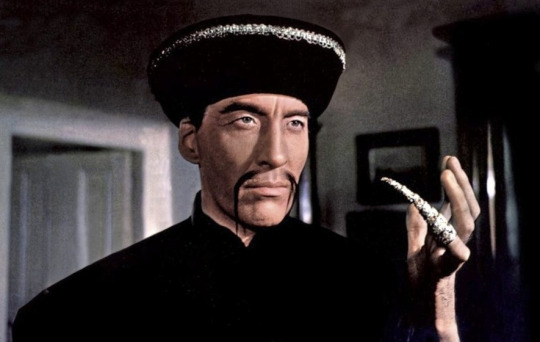
Peter Sellers portrayed Fu in his last major cinematic appearance, though unlike most other examples that film – The Fiendish Plot of Dr. Fu Manchu – was a parody, which does at least take away a little bit of the bad taste.
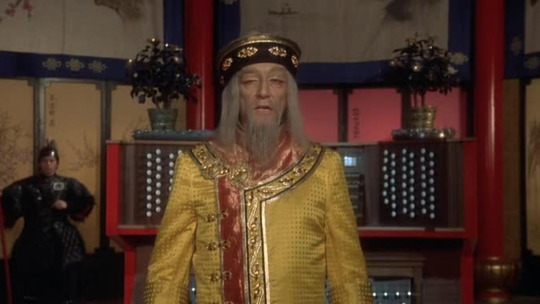
The only valid white man portrayal is, of course, from the fake trailer for Werewolf Women of the S.S. As said fake trailer is a ridiculous sendup of exploitation films and trashy cinema in general, the inclusion of a white man playing the fiendish doctor is pretty much part of the joke – but it’s who they got that’s the real treat. We’ll get to that shortly, but before that…
It is honestly really disgusting that in the long history of this character, he has never once been portrayed by an Asian actor. You’d think at some point that someone might at least just cast any sort of Asian due to the unfortunate tendency to view Asian actors as interchangeable, but they couldn’t even do that.
Final Fate: Fu Manchu is notable because he always gets away, even if his plans are foiled; in fact, he’ll sometimes have plans within plans, so even when he loses, he still wins to some degree. But enough about his in-universe fate; let’s talk about the real world fate of the character, where Fu Manchu has a very odd legal status in terms of public domain.
While the first three books are in the public domain, some characters from later books are not considered part of the public domain, which has lead to situations such as Marvel’s Master of Kung Fu not being able to be reprinted for years. On top of this, as the character’s creator Sax Rohmer died in 1959, Fu Manchu is not in the public domain in Europe; this has led to him appearing but not being directly named in Alan Moore’s The League of Extraordinary Gentlemen, where he is only referred to as “The Doctor” (amusingly, he goes up against Moriarty in that comic, the character he draws inspiration from).
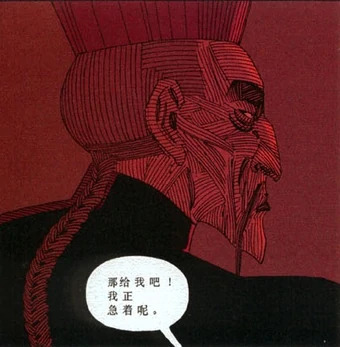
Best Scene: In what is one of the very few non-offensive uses of the character, Fu Manchu is given a brief cameo in the trailer for Werewolf Women of the S.S. that shows up in the Rodriguez/Tarantino double feature Grindhouse, and he’s played by… well… just watch:
youtube
Final Thoughts & Score: Fu Manchu is an absolutely fascinating villain born out of incredibly problematic places.
There is absolutely no denying that Fu Manchu was created from a deeply racist place. It’s an unavoidable fact. There is no getting around it. Fu Manchu as a character was meant to demonize the Chinese, to the point where production of films based on him as well as the novels was halted in times of war when the Chinese were allies. These books, these stories, are all extremely problematic by the standards of today.
But with that being said… who, exactly, is the title character? Do you know, without looking it up, who the hero who Fu Manchu antagonizes is, the Holmes to his Moriarty? This is Fu Manchu’s series, and throughout it he projects an air of intelligence, sophistication, and even honor that you wouldn’t expect would be afforded to a character such as him. As far as racist propaganda goes, an extremely charitable person could be able to call this “progressive” in some regard. Positive discrimination is a step up from regular discrimination, right? Again, there’s really no getting around the glaring problems with the character and his origins, but the fact Fu Manchu is one of the first supercriminals in literature and manages to just be unflinchingly cool to the point where you’ll probably end up rooting for him over the bland white protagonists says something for how utterly racism fails when it manages to make the object of its derision infinitely cooler than the race it’s trying to prop up as superior.
By my own criteria, Fu Manchu could only be an 11/10. I can’t deny how much of an impact, for better or for worse, the fiendish doctor has had on pop culture, to the point where he gave his name to and subsequently killed off a variety of facial hair, a feat only matched by Hitler. But this comes with a disclaimer: I cannot stress enough that Fu Manchu is deeply and inherently problematic on a conceptual level, and that despite how genuinely cool and fascinating he is in the right hands it doesn’t and cannot erase that his original purpose was to demonize the Chinese and Asian cultures. He also managed to help perpetuate yellowface and helped to popularize cliches that have plagued Asian villains to this day. While many in his wake have still managed to be cool and engaging in their own right, it really cannot be said how this character has a very complex history. Has he done more bad than good? That’s not for a white guy like me to determine; I’m merely here to determine the overall quality of the villain and determine their impact, and Fu Manchu undeniably has impacted culture. It would be wrong and disingenuous to break my own rules to give him a lower rating due to his problematic elements, but at the same time I cannot sit here and pretend they do not exist.
I would love to see the day where Fu Manchu can be reclaimed to some extent. Look at Shang-Chi, for example; the (at this time) upcoming Marvel film is set to feature the Fu Manchu-inspired Mandarin as a major character, and he is set to be played by Tony Leung Chiu-wai, a Hong Kong actor. If one of the characters inspired by him can get portrayed by an Asian actor, perhaps someday in the future Fu Manchu can be reclaimed from his racist origins and given the respectful treatment he deserves. Fu Manchu is a character that is in many ways accidentally incredible and iconic. Born from horrendous racism, and yet the racist screeds depicting him always somehow manage to prop him up as the best character in the lot… it’s the paradox of racist thought, to go so far in demonizing their target they manage to make them more interesting and engaging than the generic protagonists. Fu Manchu is a truly great villain mired in the problems of the time he was created; in the right hands, great work could be done with him.
Bottom line is: Rob Zombie, get Nicolas Cage on the phone and start filming Werewolf Women of the S.S.
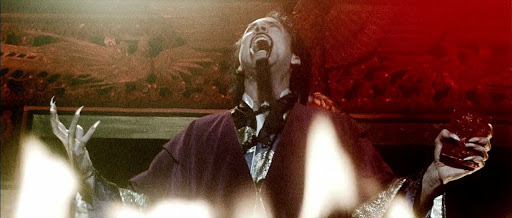
#Psycho Analysis#Fu Manchu#racism#yellow peril#racism against asians#racism against chinese#cw: racism
18 notes
·
View notes